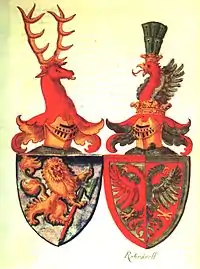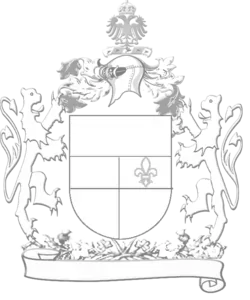Heraldic courtesy
Heraldic courtesy or courtoisie (French) is a practice typical of the heraldry of Germany (or more generally the former Holy Roman Empire), in which coats of arms are mirrored if necessary so that animate charges, such as lions, face the center of a composition. This may be done in arms of alliance (displaying the two shields of a married couple),[1][2] as in the first illustration here; or within a single shield, such as that of the dukes of Guelders and Jülich in which the gold lion of Guelders turns to face the black lion of Jülich.

Arms of alliance; the husband's lion, which would normally face dexter, instead faces sinister toward the wife's shield

Arms of the dukes of Guelders and Jülich
See also
References
- Adolf Matthias Hildebrandt (Begr.): Handbuch der Heraldik, 19. Auflage, Neustadt an der Aisch, 1998, S. 153.
- Peter, Bernhard. "Courtoisie und Wenden: Wann und wie?". Archived from the original on 2012-07-23. Retrieved 6 February 2013.
This article is issued from Wikipedia. The text is licensed under Creative Commons - Attribution - Sharealike. Additional terms may apply for the media files.
